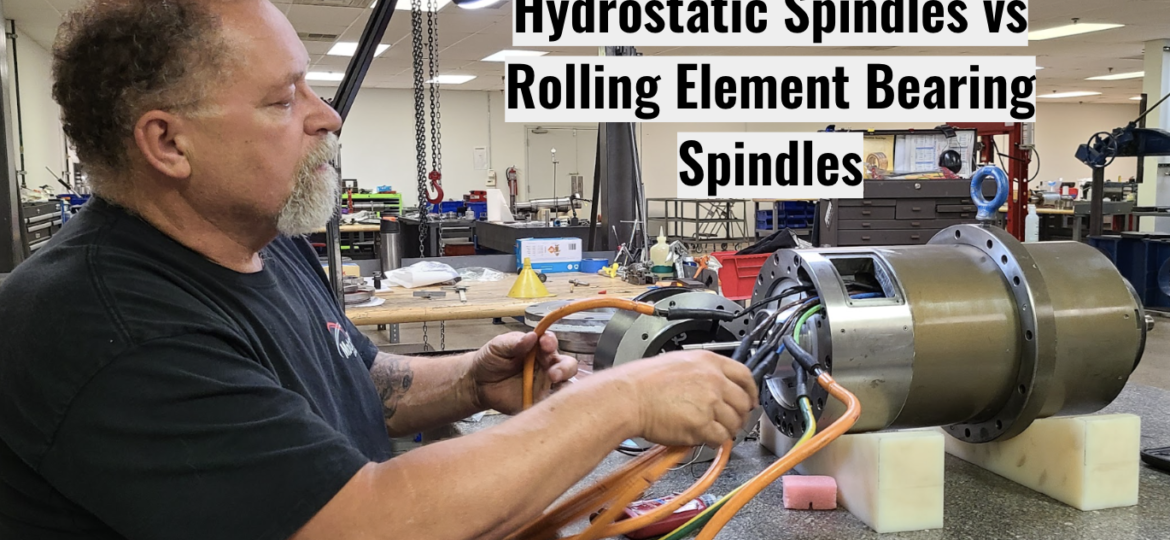
Hydrostatic Spindles vs Rolling Element Bearing Spindles
Hydrostatic spindles and CNC machine tool spindles with rolling element bearings are two different types of spindles used in machining applications. Here are the key differences between them:
- Bearing Mechanism: The main difference lies in the bearing mechanism. In CNC machine tool spindles with rolling element bearings, the spindle is supported by rolling elements such as balls or rollers that facilitate smooth rotation. On the other hand, hydrostatic spindles use a fluid film to provide support and reduce friction between the spindle and its housing.
- Friction and Heat: Hydrostatic spindles offer advantages in terms of reduced friction and heat generation. The fluid film in a hydrostatic spindle creates a thin layer of lubrication that helps minimize friction, resulting in lower heat generation during operation. In contrast, rolling element bearings generate more friction and can lead to higher operating temperatures.
- Load Capacity: Hydrostatic spindles typically have a higher load capacity compared to spindles with rolling element bearings. The hydrostatic pressure created by the fluid film enables them to handle heavy loads effectively. Rolling element bearings have certain load limits and may not be suitable for extremely heavy machining applications.
- Stiffness and Damping: Hydrostatic spindles offer excellent stiffness and damping characteristics. The fluid film in the hydrostatic bearing system provides high stiffness, which is beneficial for maintaining stability during machining processes. Additionally, the fluid film damping properties help absorb vibrations, leading to improved surface finish and accuracy. Rolling element bearings have lower damping capabilities and may transmit more vibrations to the tool and workpiece.
- Maintenance and Precision: CNC machine tool spindles with rolling element bearings are generally easier to maintain and replace. Rolling element bearings have a predictable lifespan and can be readily replaced when worn or damaged. Hydrostatic spindles, while offering superior performance, require more sophisticated maintenance and monitoring due to the fluid film system.
Overall, hydrostatic spindles excel in high-load, high-precision applications where low friction, high stiffness, and damping are crucial. CNC machine tool spindles with rolling element bearings are more commonly used in general machining operations and may be easier to maintain and replace. The choice between the two depends on the specific machining requirements, load capacity, precision needs, and operating conditions.
THE CNC SPINDLE REPAIR EXPERTS
Motor City Spindle Repair specializes in Spindle Repair in all areas, and we are able to provide quality services for below :
Horizontal Machining Centers Spindle Repair,
Vertical Machining Centers Spindle Repair,
Turning Centers Spindle Repair,
Grinding Machines Spindle Repair,
Precision Machine Tool Spindle Application Repair,
with Emergency Repair Lead Times,
We rebuild Belt Driven, Gear Driven, and Direct Driven spindles.
CONTACT US ANYTIME IF YOU’D LIKE TO CHAT WITH OUR EXPERTS OR STOP BY OUR 25,000 SF MANUFACTURING FACILITY LOCATED IN DEARBORN, MICHIGAN!
(734) 261-8600 OR EMAIL US AT SALES@MOTORCITYREPAIR.COM
*Quotations are 100% free of charge
*All quotes are accompanied by a detailed failure analysis report
*We frequently repair spindles in 2-5 business days in emergency situations
*Normal time averages 1-3 weeks for standard repairs
*We keep precision bearings, seals, o-rings, encoders, and other commonly replaced spindle parts in stock and on hand
*Always available 24 hours a day and 7 days a week for emergency repair service
*We deliver the repaired product to you
*Our repairs are balanced, test ran, and certified with a full 1 Year Warranty
*We repair or build new depending on your needs
*Guaranteed cost savings
Need a FREE ESTIMATE? Click HERE To view our most recent blog post, click HERE Have questions about ballscrews? Check out our BALL SCREW WEBSITE

